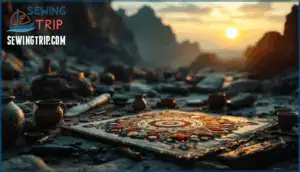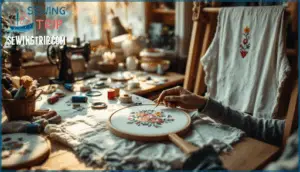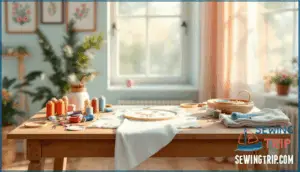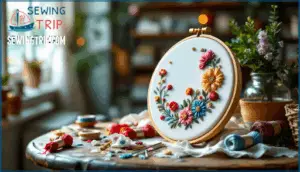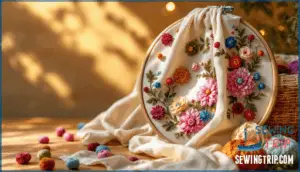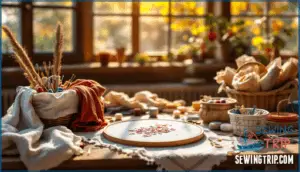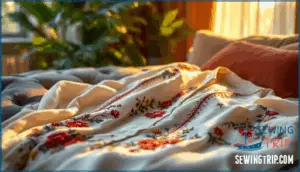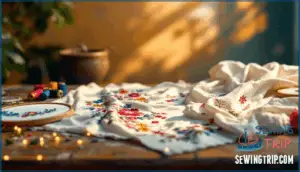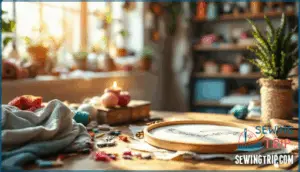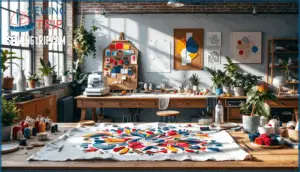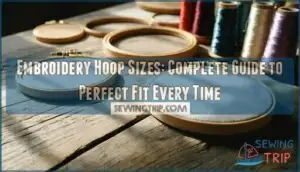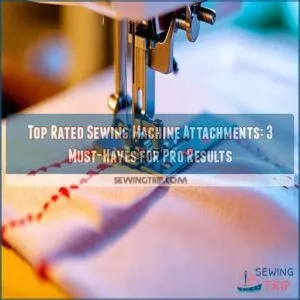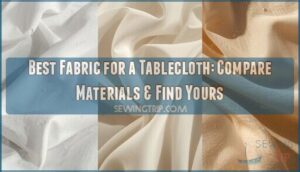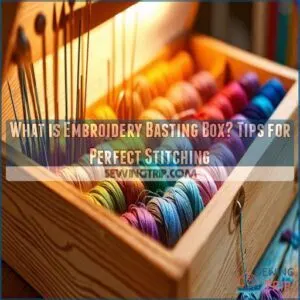This site is supported by our readers. We may earn a commission, at no cost to you, if you purchase through links.
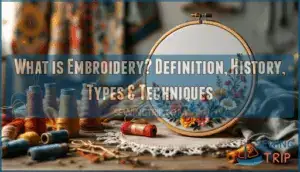
It’s been around for tens of thousands of years, evolving from hand-stitched ceremonial robes in ancient civilizations to today’s high-speed computerized machines that can reproduce intricate patterns in minutes.
Whether you’re drawn to traditional hand stitching or curious about modern machine techniques, understanding the fundamentals opens up a world of creative possibilities—from simple monograms to complex textile art.
Table Of Contents
- Key Takeaways
- What is Embroidery?
- How Did Embroidery Originate?
- What Are The Main Types of Embroidery?
- Which Techniques and Stitches Are Used?
- What Materials and Tools Are Essential?
- Where is Embroidery Commonly Used?
- Why Choose Embroidery Over Other Methods?
- How to Start Embroidering as a Beginner
- What Are The Latest Trends in Embroidery?
- Frequently Asked Questions (FAQs)
- Conclusion
Key Takeaways
- Embroidery creates raised, three-dimensional designs by stitching thread onto fabric—giving you a tactile texture that flat printing or painting can’t replicate.
- The craft spans 30,000 years of history, evolving from hand-stitched status symbols in ancient civilizations to today’s high-speed computerized machines that execute intricate patterns in minutes.
- You can choose between hand embroidery for total creative control and artistic expression, or machine embroidery for precision and speed—each offering distinct advantages depending on your project goals.
- Embroidery outlasts other decoration methods through durability that withstands hundreds of washes while maintaining its shape, color, and visual impact across virtually any fabric surface.
What is Embroidery?
Embroidery is the craft of decorating fabric with needle and thread, creating designs that range from simple patterns to intricate artwork. The technique gives your work a raised, textured feel that sets it apart from flat prints or painted designs.
Let’s break down what makes embroidery unique, how it looks and feels on fabric, and the characteristics that define this timeless art form.
Definition and Core Concepts
Embroidery is the art of decorating fabric with needle and thread—turning plain material into something textured, personal, and eye-catching. It’s a blend of craftsmanship and creativity that uses embroidery stitches to create patterns, words, or images directly onto fabric.
Whether it’s hand embroidery or machine work, this needlework gives designs a raised, three-dimensional quality that stands out—literally. You’re not just adding color; you’re building texture.
How Embroidery Looks and Feels
When you run your fingers over embroidery, you’ll feel the difference right away—it’s raised, textured, and three-dimensional, not flat like printed designs. That tactile experience comes from layered embroidery stitches building up on the fabric surface.
Visually, the dimensional effects catch light differently than plain textile art, creating shadows and depth. This sensory perception—how embroidery patterns look and feel—is what makes decorative designs pop off the material.
Key Characteristics of Embroidery
Beyond that textured feel, embroidery has a few standout traits that set it apart from other fabric decoration methods.
- Texture Effects: Embroidery stitches create dimensional details that you can see and touch
- Stitch Variations: Different embroidery techniques—from hand embroidery to machine work—offer endless creative possibilities
- Fabric Choices: Works on nearly any material, from delicate silk to heavy denim
- Color Combinations: Layering threads produces rich, complex hues that printing can’t match
How Did Embroidery Originate?
Embroidery didn’t just show up overnight—it’s been around for tens of thousands of years, evolving alongside human civilization itself. From ancient burial sites to royal treasures, the craft has left its mark across every corner of the globe. Let’s trace the thread back through time and see where it all began.
Early Historical Evidence
You won’t believe this—decorative stitching on fossilized clothing from 30,000 BC marks the earliest evidence of embroidery. Archaeological discoveries in Siberia revealed drilled shells stitched onto garments dating back to 5000–6000 BC, while prehistoric finds in China include embroidery instructions on paper from 3500 BC. These ancient stitching techniques weren’t just craft—they were power moves, status symbols passed down through generations.
The history of embroidery is deeply rooted in ancient cultural practices.
| Historical Textiles | Time Period |
|---|---|
| Fossilized decorative stitching | 30,000 BC |
| Drilled shells on garments (Siberia) | 5000–6000 BC |
| Chinese embroidery instructions | 3500 BC |
Ancient Civilizations and Embroidery
Empires built their reputations thread by thread—ancient Egyptian embroidery flourished around 5000 BCE, using plant-dyed linen adorned with lotus flowers and hieroglyphs that screamed power and divinity. Chinese silk embroidery emerged during the Warring States period (475–221 BCE), while Indian embroidery traced back to the Indus Valley Civilization, setting standards for centuries to come.
- Ancient Egyptian: Linen base with symbolic motifs marking royal status and religious devotion
- Chinese Silk: Dragon and phoenix designs on silk, perfected during the Han Dynasty (206 BCE–220 CE)
- Mesopotamian Textiles: Ceremonial embroidery from 2500 BCE featuring mythological figures reserved for elite classes
- Greek and Roman Needlework: Gold-thread embroidery on tunics demonstrating virtue, wealth, and social rank by 500 BCE
The art of embroidery is deeply rooted in ancient textile techniques that have been passed down through generations.
Evolution Through The Ages
Cultural exchange fueled embroidery’s transformation—Medieval Advances introduced Opus Anglicanum in England, where silk and gold threads exceeded 1,000 stitches per square inch by the 12th century.
Renaissance Embroidery brought Italian double-sided satin stitch masterpieces, while the first embroidery pattern book appeared in 1520s Germany.
Industrial Innovations followed with Switzerland’s 1828 commercial machines, democratizing what Ancient Influences had reserved for royalty—each era layering new embroidery techniques onto centuries of tradition.
What Are The Main Types of Embroidery?
Embroidery isn’t a one-size-fits-all craft—it branches into different approaches depending on how you work and what you’re creating. The main divide comes down to whether you’re stitching by hand or using a machine, but within those categories, you’ll find dozens of styles and methods worth exploring.
Let’s break down the key types you’ll encounter.
Hand Embroidery
Hand embroidery is the original, hands-on way to stitch—just you, a needle, some thread, and the fabric in front of you. It’s pure artistic expression, letting you control every detail through embroidery stitches like backstitch or French knots.
You pick your thread choices, fabric selection, and embroidery patterns—no machine dictates the pace. These embroidery techniques and needlework traditions give you total creative freedom with minimal embroidery tools.
Machine Embroidery
Machine embroidery flips the script—instead of controlling every stitch by hand, you let a computerized machine manage the precision while you focus on the design.
You’ll use embroidery software for digitizing your artwork, then the embroidery machine reads that file and executes automated designs with perfect thread management.
Multihead industrial embroidery machines can even stitch multiple pieces simultaneously, blending digital stitching with traditional embroidery techniques—it’s fast, consistent, and opens up complex patterns that’d take forever by hand.
Popular Styles and Methods
Once you’ve got the basics down, you’ll find embroidery branches into dozens of distinct styles—each with its own visual language, cultural roots, and technical demands.
Cross stitch uses X-shaped stitches on gridded fabric for geometric designs, while crewel embroidery layers wool threads for rich, textured florals. Blackwork creates striking monochrome patterns, thread painting mimics brush strokes with blended stitches, and stumpwork builds 3D sculptural effects through padding and wire—so pick what speaks to your creative vision.
Which Techniques and Stitches Are Used?
Once you know the basic embroidery types, you’ll want to get your hands on the actual stitches that bring designs to life.
Mastering a handful of core techniques opens up endless creative possibilities, from simple outlines to richly textured details.
Let’s break down the essential stitches and how you can combine them to level up your work.
Basic Hand Embroidery Stitches
- Backstitch creates solid lines perfect for outlines and lettering
- Running stitch adds dashed details that weave through embroidery patterns effortlessly
- Straight stitch offers flexibility for fills and textures in hand embroidery
Specialty and Decorative Stitches
After you’ve gotten comfortable with the basics, specialty stitches open up a whole new world of texture and dimension that can take your work from simple to show-stopping. French knots create raised dots perfect for flower centers or starry skies, while stem stitch curves smoothly around design patterns with rope-like texture.
Thread choices and fabric selection really matter here—stitch variations like satin stitch demand tension control, and embellishment techniques shine when you match specialty stitches to your vision.
Combining Multiple Techniques
The real magic happens when you layer different stitches together, mixing textures and dimensions to build embroidery that feels alive and intentional. Try these fusion embroidery approaches:
- Layered designs with satin stitch backgrounds topped by French knots for depth
- Hybrid stitches blending backstitch outlines with stem stitch fills
- Textile blending combining hand embroidery techniques with appliqué or beadwork
Mixed media opens creative doors you didn’t know existed.
What Materials and Tools Are Essential?
You can’t start embroidering without the right gear in hand. The fabric you choose, the threads you work with, and the tools that secure everything in place all shape how your project turns out.
Let’s break down what you actually need to get started.
Fabrics for Embroidery
Your fabric choice matters more than you might think—it’s the canvas that holds every stitch, influences your thread tension, and determines whether your finished piece feels sturdy or delicate.
Cotton fabrics are beginner-friendly and adaptable for most embroidery supplies, while linen textures offer a crisp, traditional feel for textile art. Aida fabric works perfectly for cross-stitch, and silk threads glide beautifully on smooth weaves. Wool blends add warmth to fabric art, while synthetic materials resist wrinkles and withstand repeated washing.
Threads and Needles
Once you’ve chosen your fabric, the next step is pairing it with the right thread and needle—because even the most beautiful fabric won’t cooperate with the wrong tools.
Embroidery floss comes in endless thread colors, while specialized needles accommodate different yarn weights and fabric selection. Matching needle types to your embroidery thread secures proper stitch tension, whether you’re tackling thread painting or basic stitches with your embroidery supplies.
Hoops, Frames, and Accessories
Embroidery hoops and frames are the unsung heroes that keep your fabric taut and your stitches consistent—think of them as the backstage crew that makes the whole show possible. Round embroidery hoops work brilliantly for hand embroidery, while frame types offer stability for larger projects.
Don’t overlook the small stuff either—needle threaders save your sanity, fabric stabilizers prevent puckering, and stitch guides keep your embroidery thread behaving exactly as it should.
Where is Embroidery Commonly Used?
Embroidery isn’t just for show—it’s everywhere, working hard in ways you mightn’t expect. From the clothes you wear to the spaces you call home, embroidery adds personality, quality, and polish to countless everyday items.
Let’s break down where you’ll find this craft making its mark most often.
Fashion and Apparel
From custom monograms on denim jackets to intricate logos on team uniforms, embroidery has become the go-to technique for turning everyday clothing into wearable art. Brands lean on custom embroidery for tailored apparel and unique clothing embellishments that add texture and dimension.
You’ll spot it everywhere in the fashion industry—from high-end couture gowns to streetwear hoodies. It’s how style customization meets textile innovation, giving your wardrobe that handcrafted edge.
Home Décor and Accessories
Pillows, curtains, table linens—embroidery transforms your living space from plain to customized with decorative needlework that catches the eye and invites touch.
Think embroidered cushions with bold embroidery patterns, wall hangings featuring hand embroidery, or table runners stitched with folk motifs. Fabric panels, decorative pillows, and even upholstered headboards gain character through stitch techniques that turn functional pieces into statement-makers.
With embroidery supplies more accessible than ever, you can craft custom home accents that reflect your vibe.
Branding and Personalization
Logos, uniforms, corporate gear—businesses lean on embroidery to stamp their identity onto fabric in a way that screams quality and permanence. Custom embroidered patches, tailored gifts, and corporate apparel turn branding into something you can touch and trust.
From custom logos on polos to embroidery services for fashion labels, this technique elevates marketing strategies by blending brand identity with craftsmanship that lasts through countless washes and wears.
Why Choose Embroidery Over Other Methods?
When you’re deciding how to add a design to fabric, embroidery stands out for reasons that go beyond just looks. It offers benefits that other decoration methods can’t quite match—from the way it holds up over time to the premium feel it brings to any project.
Let’s break down what makes embroidery worth choosing.
High-End, Textured Finish
There’s something undeniably luxurious about embroidery—it catches the light, invites your fingers to trace its ridges, and gives even the simplest fabric a premium feel. That’s what sets textile art apart:
- Dimensional effects create shadows and depth you can’t get with flat printing
- Complex stitches layer thread to build richness and visual weight
- Luxury fabrics gain instant sophistication through textured designs
- High-end materials like silk or metallic threads enhance embroidery design patterns
- Artistic expression transforms ordinary garments into statement pieces through embroidery techniques
It’s the difference between wearing something and experiencing it.
Durability and Longevity
You could wash an embroidered jacket a hundred times and the design would still retain its shape—try that with screen printing or vinyl and you’ll see the difference fast. Thread quality and fabric resistance make embroidery techniques outlast other methods by years.
Hand embroidery especially shines when you’re testing for wear—those stitches lock into the weave and resist color fading like nothing else. With proper embroidery supplies and materials, your textile art stays sharp and longlasting through real-world use.
Versatility Across Applications
Whether you’re stitching a logo on a corporate polo or adding a personal touch to a canvas tote, embroidery adjusts to nearly every surface and purpose you can imagine. From fashion embellishments to home decor, custom embroidery services reveal endless possibilities:
- Brand identity through sharp corporate logos
- Cultural symbolism woven into textile art pieces
- Flexibility across apparel types, from caps to jackets
That’s what makes embroidery techniques so powerful—they work wherever you need lasting visual impact.
How to Start Embroidering as a Beginner
Getting started with embroidery doesn’t require a huge investment or years of experience—just a handful of basic supplies and a willingness to learn as you go. You’ll want to gather your materials first, figure out how to transfer patterns onto fabric, and then jump into simple projects that build your confidence.
Let’s break down each step so you can start stitching without feeling overwhelmed.
Gathering Basic Supplies
Before you thread your first needle, let’s talk about the handful of tools that’ll actually get you stitching—no fancy craft store haul required. Start with embroidery floss (six-strand cotton thread), a few embroidery needles in different sizes, and a 4-6 inch wooden hoop to keep your fabric taut.
| Supply | What to Get | Why It Matters |
|---|---|---|
| Embroidery Floss | Cotton six-strand thread in 3-5 colors | Separable strands let you control thickness |
| Needles | Size 5-10 embroidery needles | Sharp tips pierce fabric cleanly |
| Hoop | 4-6 inch wooden or plastic hoop | Keeps tension even while you stitch |
| Fabric | Cotton or linen blend | Stable weave won’t pucker or distort |
Fabric choices matter too—cotton or linen blends work beautifully for beginners. Grab some scrap fabric to practice your first stitches, and you’re ready to roll. These embroidery materials and tools will carry you through dozens of projects before you’ll need anything fancier.
Transferring Patterns to Fabric
Now that you’ve got your supplies lined up, it’s time to get your design onto the fabric—and trust me, this step isn’t as tricky as it looks. You can trace embroidery patterns with a water-soluble pen, use iron-on designs for quick transfers, or try the window method—taping your pattern and fabric preparation together against glass.
Transfer techniques like heat-transfer pencils work great for hand embroidery, while stabilizer methods keep things smooth for detailed stitch sampler projects with embroidery floss.
Starting Simple Projects
Once your pattern’s in place, pick something small to cut your teeth on—a bookmark, a simple leaf motif, or even your initials stitched onto a scrap square. Start with beginner embroidery projects that let you practice basic embroidery stitches without overthinking it:
Here are some tips to get you started:
- Fabric choice: Cotton or linen works best for hand embroidery
- Thread selection: Standard six-strand embroidery floss is your friend
- Simple designs: Stick to basic stitches like backstitch or running stitch
- Beginner kits: They bundle embroidery patterns with everything you need
- Practice stitching: Repetition builds confidence faster than excellence
What Are The Latest Trends in Embroidery?
Embroidery isn’t stuck in the past—it’s evolving fast, blending traditional craft with fresh ideas and advanced tech. From artists pushing boundaries with thread to machines that can stitch almost anything you can imagine, the field’s more exciting than ever.
Let’s look at what’s shaking up the embroidery world right now.
Contemporary Embroidery Art
Today’s embroidery artists are breaking every rule in the book, turning what was once considered a "grandma craft" into a vibrant, rebellious art form that’s showing up in galleries, on streetwear, and across social media feeds worldwide.
Contemporary embroidery art pushes past tradition with experimental stitches, mixed media layering, and unexpected sustainable materials—think embroidered portraits on denim or sculptural thread installations that blur the line between hand embroidery and modern art forms.
| Trend | Description | Example |
|---|---|---|
| Textile Portraits | Photorealistic faces stitched with thread | Hand-embroidered self-portraits |
| Street Art Fusion | Embroidery on urban wear and sneakers | Patches on bomber jackets |
| 3D Installations | Sculptural pieces using embroidery techniques and stitches | Fiber art exhibits |
Digital and Machine Innovations
Behind the scenes, machine embroidery is entering a new era powered by AI stitching and automated digitizing tools that slash production time by 60%. Cloud embroidery platforms let you sync digital designs across devices instantly, while machine learning algorithms refine stitch paths for different fabrics.
Smart textiles now integrate sensors directly into embroidery machine workflows, and computer-generated designs achieve 98% precision—transforming how you create, whether you’re running an industrial setup or experimenting with advanced wearable tech.
Frequently Asked Questions (FAQs)
What is the difference between cross stitch and embroidery?
Cross-stitch is actually a specific type of hand embroidery—think of it as a focused technique within the broader embroidery universe. Cross-stitch uses X-shaped Stitch Patterns on gridded Fabric Choices like Aida cloth, while embroidery encompasses countless techniques, Thread Types, needle work styles, and Embellishment Techniques to create free-form designs.
What is embroidery & how does it work?
Embroidery works by stitching thread through fabric using a needle—either by hand or machine—to form decorative patterns. Each stitch builds texture and dimension, creating raised designs that stand out from the surface.
The process combines fabric selection, thread types, and stitch patterns to achieve unique embellishments.
What are the different types of embroidery?
Hand embroidery creates intricate designs by needle and thread—think cross stitch, crewel work, and blackwork. Machine embroidery speeds things up with computerized precision. Then there’s appliqué, stumpwork, and specialty techniques like 3D puff for bold, textured effects.
How do you explain embroidery?
Like a signature stamped in thread, embroidery transforms plain fabric into something unmistakably yours. It’s the craft of stitching decorative designs onto material using needle and thread, creating raised textures that catch the eye.
From hand embroidery techniques passed through generations to modern machine methods, the possibilities span endless stitch variations and thread colors across any fabric selection you choose.
What is embroidery vs sewing?
Sewing joins fabric pieces together using stitches, while embroidery techniques add decorative needlework and thread art onto fabric surfaces. Both use needle and thread, but embellishment techniques in hand embroidery create raised, textured fabric decoration rather than structural connections.
What is the purpose of embroidery?
Picture a single thread turning plain cloth into something that tells a story. Embroidery acts as artistic expression, cultural preservation, and personal decoration.
It transforms fabric through hand embroidery techniques and decorative art into fashion statements with therapeutic benefits and lasting cultural significance.
What is embroidery examples?
Common examples include monograms on towels, floral motifs on clothing, logos on uniforms, decorative patterns on pillows, and cross-stitch samplers.
These embroidery designs showcase various stitch patterns, thread colors, and embellishments across different types of embroidery and hand embroidery techniques.
What is the easiest way to embroider?
Start with beginner embroidery kits—they include simple patterns, easy stitches like running stitch or backstitch, and pre-printed fabric.
Hand embroidery techniques feel straightforward for beginners, and learning embroidery online offers quick projects with step-by-step beginner tips.
What is embroidery & how does it work?
You’re basically using thread like a pixel artist uses color—building images stitch by stitch.
Embroidery techniques layer hand embroidery or machine needlework onto fabric choices, creating textured embellishment techniques with stitch patterns and thread colors.
How long does it take to complete an embroidery project?
Project timelines vary wildly—a simple hand embroidery bookmark might take an hour, while intricate stitching on large designs can stretch into weeks.
Stitch complexity, design size, fabric choices, and thread selection all affect how long embroidery projects take using different embroidery techniques and methods.
Conclusion
Ready to pick up a needle and thread? Now that you understand what embroidery is—from its ancient roots to modern machine innovations—you’ve got the foundation to start stitching your own designs or simply appreciate the craft with fresh eyes.
Whether you’re drawn to hand-stitched heirlooms or bold contemporary fiber art, embroidery offers a tactile, durable way to add personality to fabric. The techniques are timeless, but the creative possibilities? Those are entirely yours to explore.
- https://nextembroidery.com/blog/embroidery-history-fun-facts/
- https://www.vam.ac.uk/articles/embroidery-a-history-of-needlework-samplers
- https://www.advanceprintwear.co.uk/blog/history-of-embroidery
- https://nwcustomapparel.net/history-of-embroidery/
- https://datahorizzonresearch.com/embroidery-market-3701

